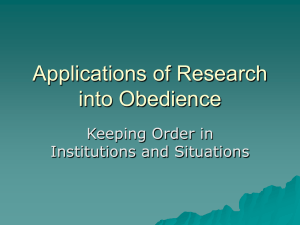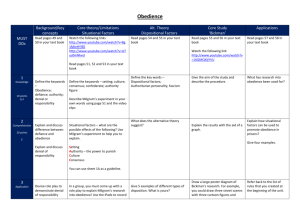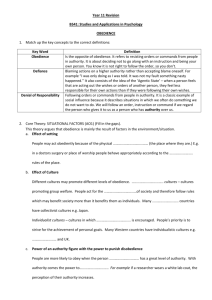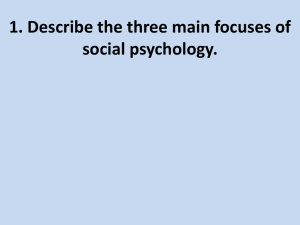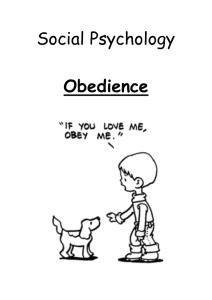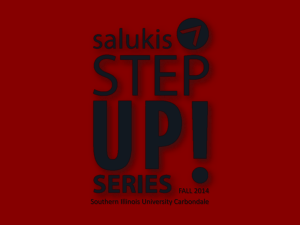Bickman 13rd Feb - The Grange School Blogs
advertisement
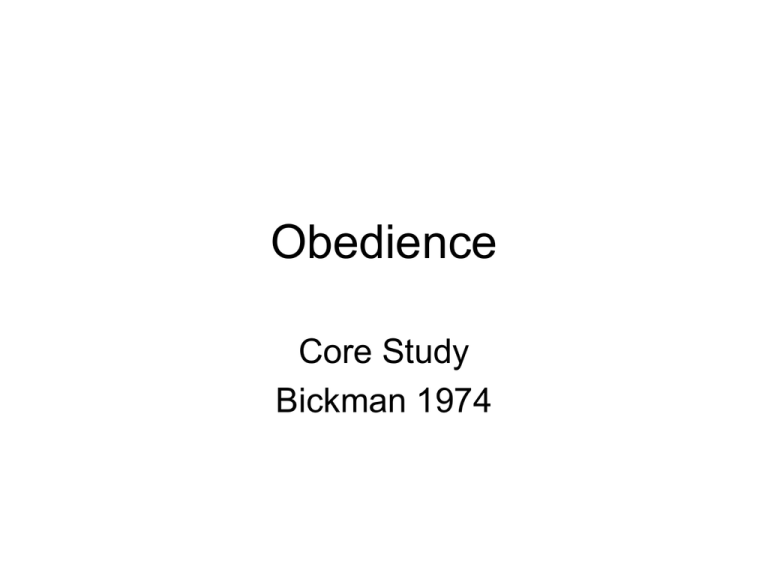
Obedience Core Study Bickman 1974 Core Study BATs • Explain and outline Bickman’s research into obedience and the power of uniform • Plan and collect data on a replication of Bickman’s research • Evaluate Bickman’s research Homework Answer questions 1-8 Activity 4.8 p57 What makes someone obey? • Setting • Number of people around (consensus) • Culture • Does the appearance of a person in authority make a difference? Can you identify these uniforms? Who are you most likely to obey? Bickman 1974 Aim – Does appearance affect how people obey others? Why did each person have to Procedure – dress up in each costume? • Field experiment • 3 male experimenters – each took it in turn to dress as a civilian (jacket and tie), milkman, guard uniform (looked like a police officer) • Gave orders to 153 random pedestrians on a street in Brooklyn, New York What were the orders? • Picking up litter – ‘Pick up this bag for me.’ • Coin and parking meter – ‘This man is overparked at the meter but doesn’t have any change – give him a dime.’ • Bus Stop – ‘Don’t you know you have to stand on the other side of the pole? This sign says “No Standing”.’ Findings of Bickman’s study 89% 57% Obedience Rate (%) 33% Type of Uniform Conclusion • Demonstrated the power of certain types of uniform. • Dress can suggest authority. • When people think someone will punish them, they are more likely to obey. Do as you are told – or else!! Limitations of Bickman’s Study There was a lack of control over variables… …factors such as crowding, weather and noise could have affected obedience rates. The study was unethical… … because participants had not given consent and may have been caused distress, embarassment and discomfort. The confederates (wearing the uniform) were all men… … so there may have been a gender bias in results – would people react the same to women in uniforms? Limitations of Bickman’s Study • Pedestrians were selected by opportunity sampling – • The personality or circumstances of the participants were not known. They might have been in a hurry, depressed or just absentminded • The study was only carried out in one city in one country – • There is evidence that Culture affects obedience levels. So we can’t be sure if passers by from other cities or countries would be as obedient. Culturally Biased research Work in 3’s One of you will secretly record results Over to you … You will need to make a tally chart • We are going to try to recreate Bickman’s Field Experiment at the end of period 5!! • How could we do this? • Do you think students would be more likely to pick up litter if you were … • Dressed in normal school uniform? • Dressed in a Prefect’s black jumper and badge? What were your findings? • You can either use you own results or pool everyone’s results. • Find the percentage obedience rate of each condition • number of those who obeyed x 100 total number of people tested • Draw a bar chart of your data Can you What limitations did you experience? come to the same conclusion as Bickman? Get ready for next week … • Write a letter to a member of the School Leadership Team to invite them to be interviewed period 6 (from 3pm) next week. • Mr Cook, Mr Allister, Mrs Thomas, Miss Manteghi, Mr Evans, We MrswillWilson, be askingMr them questions about Brunnock, Mrs Skuse,some Mr Tetlow the factors that affect • Heads of School – MR, CHy, and SRn obedience their role in maintaining discipline within school. Extension • In 3s create one street scene each from Bickman’s study • Make a comic strip with cartoon and speech bubbles • Some pictures are available for you to use. Plenary • Share your cartoon – who did the best one? Why? Homework Answer questions 1-8 Activity 4.8 p57 Look at p59 Doing Research – think what questions you could ask SLT
